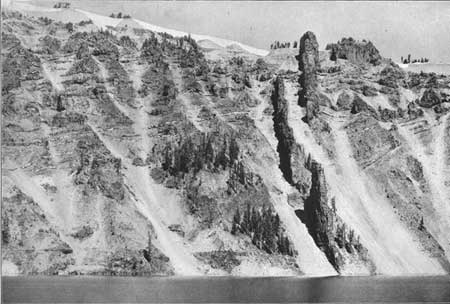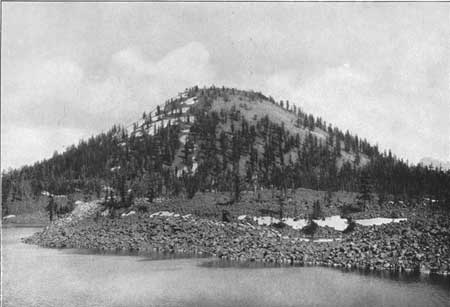The Geology and Petrography of Crater Lake National Park, 1902
PART I.
MOUNT MAZAMA.
LAVAS OF MOUNT MAZAMA.a
ANDESITES.
ANDESITIC DIKES.
A cruise on the lake reveals a number of dikes which cut the rim radially. Eleven were observed in all—seven near Llao Rock, three opposite Scott Peak, and the remaining one a short distance west of Eagle Cove. Nine of these are of andesite and two of dacite.
The only prominent dike (Pl. VIII, A) is of andesite. It cuts through the entire rim from lake to crest and stands out conspicuously between Glacier Peak and Llao Rock. It has been named the Devils Backbone. This prominent dike is nearly vertical and strikes N. 50° W. It varies from 5 to 20 feet in thickness, and offsets near the middle of the slope. The sample of this rock (94) was taken on the crest, and in the mass, to the unaided eye, it resembles gray basalt more than the normal andesitic rock of the rim. On microscopical evidence Dr. Patton refers it to the andesites. It has a columnar structure across the dike and a less conspicuous parting near the sides parallel to the contact with the adjacent rock.
Plate VIII—A. DEVILS BACKBONE.
Plate VIII—B. WIZARD ISLAND.
Under the east end of Llao Rock are two dikes, of which the southern one is remarkable. It first appears with a width of 15 feet at the top of a talus slope 100 feet above the lake, and has a vitrophyric border. Upward it thickens slightly as it rises for several hundred feet, then expands into a sheet of lava which was a surface flow on the slope of the growing volcano at the time the dike was formed. At the lower end of the dike No. 95 was collected, and No. 91 represents the adjacent andesite.
A short distance farther northeast is another 15-foot dike, which spreads into a sheet about 500 feet above the lake. The material, although andesite, is rather dacitic (132). It is full of secretions (133) which are somewhat basaltic in their character.
On the west arm of Steel Bay is a 12-foot dike which has a dacitic aspect, but proved under the microscope to be an andesite. About halfway up the rim it expands, connecting with the great flow, 200 feet thick, extending from Llao Rock to the northeast corner of Steel Bay. It fills a fissure in the mountain side from which a large part of the flow escaped. This dike, as well as most of the others, is much older than the one on the Devils Backbone.
No dikes were seen around the northern and southern shore of the lake, but at the southern end of Redcloud Cliff, under the great rhyolite flow of Cloud Cap, three more dikes appear. The one at Sentinel Rock (33) is irregular, 10 to 25 feet in width, with a number of secretions, and for a short distance is cut up into a large mass of conglomerate. Farther north is a 4-foot dike (21) which strikes a little north of east. The transverse jointing in it is especially well developed. It intersects sheets of lava and conglomerate, but does not reach quite to the great flow of dacite above. Almost directly under Cloud Cap is another interrupted dike, trending southeast. Although the dikes noticed thus far are of andesite, and earlier than the great dacite flows, their association with the portions of the rim over which these dacite flows emanated is of interest.
A short distance west of Eagle Cove, about halfway between the crest and the lake, is a 10-foot dike with horizontal jointing. It runs down the slope to the water, and at one point stands out as a prominent ledge 50 feet in height.
Under The Watchman is a dike which reaches neither to the crest nor to the water’s edge. It is about 40 feet in width and its border is black and glassy, like the vitrophyric dacite of Llao Rock, but near the middle it appears holocrystalline, within a light-gray color peppered with small dark crystals of pyroxene.



